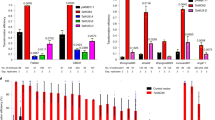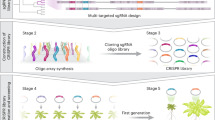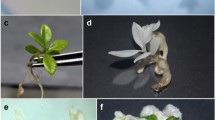Abstract
Selectable markers enable transgenic plants or cells to be identified after transformation. They can be divided into positive and negative markers conferring a selective advantage or disadvantage, respectively. We present a marker gene, dao1, encoding D-amino acid oxidase (DAAO, EC 1.4.3.3) that can be used for either positive or negative selection, depending on the substrate. DAAO catalyzes the oxidative deamination of a range of D-amino acids1. Selection is based on differences in the toxicity of different D-amino acids and their metabolites to plants. Thus, D-alanine and D-serine are toxic to plants, but are metabolized by DAAO into nontoxic products, whereas D-isoleucine and D-valine have low toxicity, but are metabolized by DAAO into the toxic keto acids 3-methyl-2-oxopentanoate and 3-methyl-2-oxobutanoate, respectively. Hence, both positive and negative selection is possible with the same marker gene. The marker has been successfully established in Arabidopsis thaliana, and proven to be versatile, rapidly yielding unambiguous results, and allowing selection immediately after germination.
This is a preview of subscription content, access via your institution
Access options
Subscribe to this journal
Receive 12 print issues and online access
$209.00 per year
only $17.42 per issue
Buy this article
- Purchase on Springer Link
- Instant access to full article PDF
Prices may be subject to local taxes which are calculated during checkout


Similar content being viewed by others
References
Alonso, J. et al. D-amino acid oxidase gene from Rhodotorula gracilis (Rhodosporidium toruloides) ATCC 26217. Microbiol. 144, 1095–1101 (1998).
Pilone, M.S. D-amino acid oxidase: new findings. Cell. Mol. Life. Sci. 57, 1732–1747 (2000).
Frommer, W.B., Hummel, S., Unseld, M. & Ninnemann, O. Seed and vascular expression of a high-affinity transporter for cationic amino acids in Arabidopsis. Proc. Natl. Acad. Sci. USA 92, 12036–12040 (1995).
Boorer, K.J. et al. Kinetics and specificity of a H+/amino acid transporter from Arabidopsis thaliana. J. Biol. Chem. 271, 2213–2220 (1996).
Umhau, S. et al. The x-ray structure of D-amino acid oxidase at very high resolution identifies the chemical mechanism of flavin-dependent substrate dehydrogenation. Proc. Natl. Acad. Sci. USA 97, 12463–12468 (2000).
Yurimoto, H., Hasegawa, T., Sakai, Y. & Kato, N. Physiological role of the D-amino acid oxidase gene DAO1, in carbon and nitrogen metabolism in the methylotrophic yeast Candida boidini. Yeast 16, 1217–1227 (2000).
Gabler, M., Hensel, M. & Fischer, L. Detection and substrate selectivity of new microbial D-amino acid oxidases. Enzyme Microb. Techno. 27, 605–611 (2000).
Lindsey, K. & Gallois, P. Transformation of sugar beet (Beta vulgaris) by Agrobacterium tumefaciens. J. Exp. Bot. 41, 529–536 (1990).
Gamburg, K.Z. & Rekoslavskaya, N.I. Formation and function of D-amino acids in plants. Soviet Plant Physiol. 38, 904–912 (1991).
Cosloy, S.D. & McFall, E. Metabolism of D-serine in Escherichia coli K-12: Mechanism of growth inhibition. J. Bacteriol. 114, 685–694 (1973).
Soutourina, J., Plateau, P., Delort, F., Peirotes, A. & Blanquet, S. Functional characterization of the D-Tyr-tRNATyr deacylase from Escherichia coli. J. Biol. Chem. 274, 19109–19114 (1996).
Bruckner, H. & Westhauser, T. Chromatographic determination of L- and D-amino acids in plants. Amino acids 24, 43–55 (2003).
Kuiper, H.A., Kleter, G.A., Noteborn, H.P.J.M. & Kok, E.J. Assessment of the food safety issues related to genetically modified foods. Plant J. 27, 503–528 (2001).
Hare, P. & Chua, N.H. Excision of selectable marker genes from transgenic plants. Nat. Biotechnol. 20, 575–580 (2002).
Gleave, A.P., Mitra, D.S., Mudge, S.R. & Morris, B.A. Selectable marker-free transgenic plants without sexual crossing: transient expression of cre recombinase and use of a conditional lethal dominant gene. Plant Mol. Biol. 40, 223–235 (1999).
Sambrook, J. & Russell, D.W. in Molecular cloning: a laboratory manual, edn. 2, (Cold Spring Harbor Laboratory Press, Cold Spring Harbor, New York, 2001).
Koncz, C. & Schell, J. The promoter of T-DNA gene 5 controls the tissue-specific expression of chimaeric genes carried by a novel type of vector. Mol. Gen. Genet. 204, 383–396 (1986).
Clough, S.J. & Bent, A.F. Floral dip: a simplified method for Agrobacterium-mediated transformation of Arabidopsis thaliana. Plant J. 16, 735–743 (1998).
Murashige, T. & Skoog, F. A revised medium for rapid growth and bioassay with tobacco tissue cultures. Physiol. Plant. 15, 310–313 (1962).
Schadewaldt, P., Wendel, U. & Hammen, H.W. Determination of R- and S-3-methyl-2-oxopentanoate enantiomers in human plasma: suitable method for label enrichment analysis. J. Chrom. B. 682, 209–218 (1996).
Acknowledgements
We would like to acknowledge Margareta Zetherström for help with HPLC analyses and several colleagues for comments on earlier versions of this manuscript. Grants from The Swedish Council for Environment, Agricultural Sciences and Spatial planning, the Kempe foundation, the Wallenberg foundation and Carl Tryggers Stiftelse for financial support to T.N. is gratefully acknowledged.
Author information
Authors and Affiliations
Corresponding author
Ethics declarations
Competing interests
The company SweTree Technologies has filed a patent application on the use of D-amino acid–metabolizing enzymes as selectable markers. O.E., M.H. and T.N. are listed as the inventors on this patent application.
Rights and permissions
About this article
Cite this article
Erikson, O., Hertzberg, M. & Näsholm, T. A conditional marker gene allowing both positive and negative selection in plants. Nat Biotechnol 22, 455–458 (2004). https://doi.org/10.1038/nbt946
Received:
Accepted:
Published:
Issue Date:
DOI: https://doi.org/10.1038/nbt946
This article is cited by
-
Design of an Arabidopsis thaliana reporter line to detect heat-sensing and signaling mutants
Plant Methods (2023)
-
A novel non-antibiotic selectable marker GASA6 for plant transformation
Plant Cell, Tissue and Organ Culture (PCTOC) (2022)
-
Soil organic nitrogen: an overlooked but potentially significant contribution to crop nutrition
Plant and Soil (2021)
-
Stimulation of root growth and enhanced nitrogenous metabolite content in habanero pepper (Capsicum chinense Jacq.) treated with a d-amino acid mixture
Theoretical and Experimental Plant Physiology (2020)
-
Broad-specificity amino acid racemase, a novel non-antibiotic selectable marker for transgenic plants
Plant Biotechnology Reports (2018)



